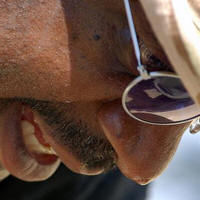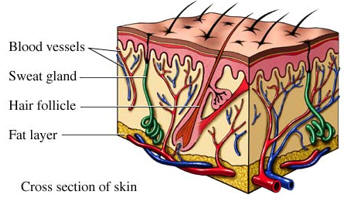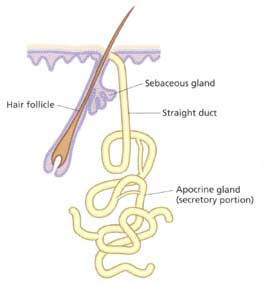How does sweat
work, why do we sweat?
 You
are about to do something really big -- maybe a job
interview, a presentation, a first date or your wedding --
and you notice that your palms and underarms are sweating.
Perhaps, you've just completed an aerobic workout and your
whole body is drenched in sweat. How can such different
activities have the same effect on your body? What is sweat
and why do we make it? You
are about to do something really big -- maybe a job
interview, a presentation, a first date or your wedding --
and you notice that your palms and underarms are sweating.
Perhaps, you've just completed an aerobic workout and your
whole body is drenched in sweat. How can such different
activities have the same effect on your body? What is sweat
and why do we make it?
Perspiration, or sweat, is your body's way of cooling
itself, whether that extra heat comes from hardworking
muscles or from overstimulated nerves. In this article, we
will examine your body's sweat glands, how sweat is made and
what it does. You will learn that there is difference
between the sweat on your palms and the sweat in your
armpits and why your skin tastes salty after a workout!
Excessive sweating -- usually on the palms of the hand or
the armpits -- that is not caused by emotional or physical
activity is called diaphoresis or hyperhidrosis. It is often
an embarrassing condition. The cause or causes are unknown,
but the condition may be due to the following:
- hormonal imbalances (e.g., menopause in women)
- overactive thyroid gland (The thyroid hormone
- increases body metabolism and heat production.)
- certain foods and medications (e.g., coffee with its
high amounts of caffeine)
- overactivity of the sympathetic nervous system.
The Sweat Gland
The average person has 2.6 million sweat glands in their
skin! Sweat glands are distributed over the entire body --
except for the lips, nipples and external genital organs.
The sweat gland is in the layer of skin called the dermis
along with other "equipment," such as nerve endings, hair
follicles and so on. The following figure illustrates what's
going on:

Basically, the sweat gland is a long, coiled, hollow tube
of cells. The coiled part in the dermis is where sweat is
produced, and the long portion is a duct that connects the
gland to the opening or pore on the skin's outer surface.
Nerve cells from the sympathetic nervous system connect to
the sweat glands. There are two types of sweat glands:
Eccrine - the most numerous type that are found all over
the body, particularly on the palms of the hands, soles of
the feet and forehead
Apocrine - mostly confined to the armpits (axillae) and
the anal-genital area. They typically end in hair follicles
rather than pores.
The two glands differ in size, the age that they become
active and the composition of the sweat that they make.
Compared to apocrine glands, eccrine glands:
- are smaller
- are active from birth (Apocrine glands become active
only at puberty)
- produce a sweat that is free of proteins and fatty acids
Did you know that the lining of your outer ear has
modified apocrine glands called ceruminous glands? These
modified sweat glands produce ear wax. Ear wax is thought to
prevent foreign material from entering your ears, including
insects.
How Sweat is Made
We are constantly sweating, even though we may not notice
it. Sweating is your body's major way of getting rid of
excess body heat, which is produced by metabolism or working
muscles. The amount of sweat produced depends upon our
states of emotion and physical activity. Sweat can be made
in response to nerve stimulation, hot air temperature,
and/or exercise. First, let's concentrate on how sweat is
made in an eccrine sweat gland.

When the sweat gland is stimulated, the cells secrete a
fluid (primary secretion) that is similar to plasma -- that
is, it is mostly water and it has high concentrations of
sodium and chloride and a low concentration of potassium --
but without the proteins and fatty acids that are normally
found in plasma. The source of this fluid is the spaces
between the cells (interstitial spaces), which get the fluid
from the blood vessels (capillaries) in the dermis. This
fluid travels from the coiled portion up through the
straight duct (Figure 2). What happens in the straight duct
depends upon the rate of sweat production or flow:
Low sweat production (rest, cool temperature) - Cells in
the straight duct reabsorb most of the sodium and chlorine
from the fluid. This happens because there is enough time
for reabsorption. In addition, water is reabsorbed
osmotically. So not much sweat reaches the outside. Also,
the composition of this sweat is significantly different
from the primary secretion. There is not as much sodium and
chloride, and there is more potassium.
High sweat production (exercise, hot temperature) - Cells
in the straight portion do not have enough time to reabsorb
all of sodium and chloride from the primary secretion. So, a
lot of sweat makes it to the surface of the skin and the
composition is close to, but not exactly like the primary
secretion. The sodium and chloride concentrations are about
half as much, and potassium is about 20 percent higher.
Sweat is produced in apocrine sweat glands in the same way.
However, the sweat from apocrine glands also contains
proteins and fatty acids, which make it thicker and give it
a milkier or yellowish colour. This is why underarm stains
in clothing appear yellowish. Sweat itself has no odour, but
when bacteria on the skin and hair metabolize the proteins
and fatty acids, they produce an unpleasant odour. This is
why deodorants and anti-perspirants are applied to the
underarms instead of the whole body.
The maximum volume of sweat that a person who is not
adapted to a hot climate can produce is about one litre per
hour. Amazingly, if you move to a hot climate such as the
American desert southwest or the tropics, your ability to
produce sweat will increase to about two to three litres per
hour within about six weeks! This appears to be the maximum
amount that you can produce.
Cooling Down using Sweat
When sweat evaporates from the surface of your skin, it
removes excess heat and cools you. This is actually due to a
neat principle in physics, which goes like this. To convert
water from a liquid to a vapour, it takes a certain amount
of heat called the heat of vaporization. This heat energy
increases the speed of the water molecules so that they can
escape into the air. Typically, all of the sweat does not
evaporate, but rather runs off your skin. In addition, not
all heat energy produced by the body is lost through sweat.
Some is directly radiated from the skin to the air and some
is lost through respiratory surfaces of the lungs.
A major factor that influences the rate of evaporation is
the relative humidity of the air around you. If the air is
humid, then it already has water vapour in it, probably near
saturation, and cannot take any more. Therefore, sweat does
not evaporate and cool your body as efficiently as when the
air is dry.
Finally, when the water in the sweat evaporates, it leaves
the salts (sodium, chloride and potassium) behind on your
skin, which is why your skin tastes salty. The loss of
excessive amounts of salt and water from your body can
quickly dehydrate you, which can lead to circulatory
problems, kidney failure and heat stroke. So, it is
important to drink plenty of fluids when you exercise or are
outside in high temperatures. Sports
drinks contain some salts to replace those lost in the
sweat.
Nervous or Scared?
As we mentioned, sweating responds to your emotional
state. So when you are nervous, anxious or afraid, there is
an increase in sympathetic nerve activity in your body as
well as an increase in epinephrine secretion from your
adrenal gland. These substances act on your sweat glands,
particularly those on the palms of your hand and your
armpits, to make sweat. Thus, you feel a "cold" sweat. Also,
the increased sympathetic nerve activity in the skin changes
it electrical resistance, which is the basis of the galvanic
skin response used in lie detector tests.
Source: How Stuff Works |
